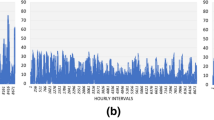Abstract
Dynamic thermal rating of overhead lines is a promising approach to increase transmission capacity by calculating weather-dependent thermal ratings (ampacities) of overhead lines in real time instead of using constant ratings. However, knowledge about ampacity is not only needed in real time but also on a day-ahead basis within network operational planning in order to assess network security. As life of humans may be endangered by inadmissible sag of overhead lines when current limits are violated there are high safety requirements concerning thermal ratings. Therefore, ampacity forecasts have to be complemented by a description of forecast uncertainty. So far, there is no method to forecast ampacities on a day-ahead basis considering uncertainty. As a comprehensive description of uncertainty is given by probability densities, this paper presents a novel method to calculate probability density functions of future ampacities based on probabilistic weather forecasts. The method’s functionality is proved by application to exemplary data.
Similar content being viewed by others
References
Davis MW (1977) A new thermal rating approach: the real time thermal rating system for strategic overhead conductor transmission lines—part I: general description and justification of the real time thermal rating system. IEEE Trans Power App Syst 96: 803–809
Seppa TO (1995) Accurate ampacity determination: temperature-sag model for operational real time ratings. IEEE Trans Power Deliv 10: 1460–1470
Adapa R, Douglass DA (2005) Dynamic thermal ratings: monitors and calculation methods. Proc Power Eng Soc Inaug Conf, pp 163–167
Deb AK (2000) Powerline ampacity system: theory, modeling and applications. CRC Press, Boca Raton
Zhang J, Pu J, McCalley JD, Stern H, Gallus WA Jr (2002) A Bayesian approach for short-term transmission overload risk assessment. IEEE Trans Power Deliv 17: 770–778
Kim DM, Kim JO (2009) Prediction of transmission-line rating based on thermal overload probability using weather models. Eur Trans Electr Power 20: 534–544
Buizza R, Houtekamer P, Pellerin G, Toth Z, Zhu Y, Wei M (2005) A comparison of the ECMWF, MSC, and NCEP global ensemble prediction systems. Mon Weather Rev 133: 1076–1097
Ringelband T (2009) Entwicklung einer Methode zur probabilistischen Prognose der Stromtragfähigkeit von Freileitungsseilen. ETG-Fachbericht 118: 149–154
Lynch P (2007) The origins of computer weather prediction and climate modeling. J Comput Phys 227: 3431–3444
Robinson AR, Lermusiaux PFJ (2000) Overview of data assimilation. Harvard Rep Phys Interdisciplin Ocean Sci 62: 1–13
Raftery AE, Gneiting T, Balabdaoui F, Polakowski M (2005) Using Bayesian model averaging to calibrate forecast ensembles. Mon Weather Rev 133: 1155–1174
Fraley C, Raftery AE, Gneiting T, McLean Sloughter J (2007) EnsembleBMA: an R package for probabilistic forecasting using ensembles and Bayesian model averaging, Technical Report No. 516. Department of Statistics, University of Washington, Seattle
National Centers for Environmental Prediction (2008) NCEP Ensemble Products. http://www.emc.ncep.noaa.gov/gmb/ens/ (accessed 2010)
Zhu Y, Toth Z, Wobus R, Richardson D, Mylne K (2002) The economic value of ensemble-based weather forecasts. Bull Am Meteorol Soc 83: 73–83
IEEE (2007) IEEE Standard for calculating the current-temperature of bare overhead conductors. IEEE Std. 738-2006
Pielke RA (1984) Mesoscale meteorological modeling. Academic Press, Orlando
Skamarock WC, Klemp JB, Dudhia J, Gill DO, Barker DM, Duda MG, Huang XY, Wang W, Powers JG (2008) A description of the advanced research WRF Version 3/National Center for Atmospheric Research. http://www.mmm.ucar.edu/wrf/users/docs/arw_v3.PDF (accessed 2008)
University Corporation for Atmospheric Research (2008) WRF Public Domain Notice. http://www.mmm.ucar.edu/wrf/users/public.html (accessed 2008)
Conradsen K, Nielsen LB (1984) Review of Weibull statistics for estimation of wind speed distributions. J Appl Meteorol 23: 1173–1183
Fisher NI (1993) Statistical analysis of circular data. Cambridge University Press, Cambridge
Dempster AP, Laird NM, Rubin DB (1977) Maximum likelihood from incomplete data via the EM algorithm. J Roy Stat Soc B Met 39: 1–38
Jiang S, Kececioglu D (1992) Maximum likelihood estimates, from censored data, for mixed-Weibull distributions. IEEE Trans Reliab 41: 248–255
Abramowitz M, Stegun IA (1964) Handbook of mathematical functions with formulas, graphs, and mathematical tables. Courier Dover Publications, New York
Deuflhard P (2004) Newton methods for nonlinear problems. Springer, Berlin
Box GEP, Muller ME (1958) A note on the generation of random normal deviates. Ann Math Stat 29: 610–611
Devroye L (1986) Non-uniform random variate generation. Springer, New York
Best DJ, Fisher NI (1979) Efficient simulation of the von Mises distribution. J Roy Stat Soc C Appl Stat 28: 152–157
Matsumoto M, Nishimura T (1998) Mersenne twister: a 623-dimensionally equidistributed uniform pseudo-random number generator. ACM Trans Model Comput Simul 8: 3–30
Rosenblatt M (1952) Remarks on a multivariate transformation. Ann Math Stat 23: 470–472
Author information
Authors and Affiliations
Corresponding author
Additional information
This work was conducted at the Institute of Power Systems and Power Economics of RWTH Aachen University. It was supported in part by the RWE Fellowship Program (RWE Studienförderung).
Rights and permissions
About this article
Cite this article
Ringelband, T., Schäfer, P. & Moser, A. Probabilistic ampacity forecasting for overhead lines using weather forecast ensembles. Electr Eng 95, 99–107 (2013). https://doi.org/10.1007/s00202-012-0244-8
Received:
Accepted:
Published:
Issue Date:
DOI: https://doi.org/10.1007/s00202-012-0244-8




